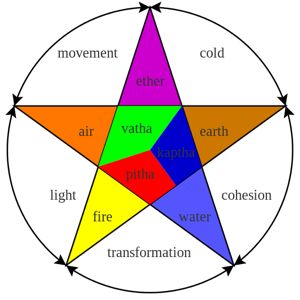As an affiliate for Bookshop, Amazon, and other programs, I may earn a small commission for products purchased through links. This doesn't affect the price you pay. Privacy policy and disclosures.
Search this site:
Ayurveda and Essential Oils to Balance Doshas
Essential oils in ayurveda complement diet and lifestyle choices to balance your body based on your dosha and sub-doshas. Let's look at ayurveda and essential oils.
 The Humors (Doshas) of Ayurveda
The Humors (Doshas) of AyurvedaAyurveda has five concepts, called elements:
- Earth represents solid matter (bones, teeth, and tissue).
- Water represents the fluids in the body.
- Fire represents bodily processes such as digestion.
- Wind represents gaseous processes in the body, including breathing.
- Ether represents space in the body.
These elements express processes, not absolutes, and combine to form three energies (humors or doshas) that govern the body:
- Vata (ether and air) is cold and dry.
- Pitta (fire and water) is hot and wet.
- Kapha (water and earth) is cold and wet.
You have a predominant dosha, plus each dosha has five sub-doshas, giving you a unique constitution (or prikriti). Ayurveda treats you based not only on your symptoms but also on your constitution. Thus, two people with the same symptoms may receive different treatments.
How do ayurveda and essential oils work together?
Marma Points of Ayurveda (Lad and Durve, 2015, chapter 15) explains that essential oils have an affinity to various structures of the body. Applying essential oils to specific marma points engages the sensory perceptions of smell and touch. Essential oils act through the olfactory bulb in the nose and chemoreceptors under the skin to change the body's neurochemistry and trigger the release of neurotransmitters and neuropeptides. The influence of oils comes from three fields of action:
- Rasa (taste: sweet, sour, pungent, astringent, bitter, or salty)
- Virya (energy: heating or cooling)
- Vipaka (post-digestive taste: sweet, sour, or pungent)
Suggested resource: Ayurveda & Aromatherapy: The Earth Essential Guide to Ancient Wisdom and Modern Healing. This book explains how to use essential oils in a way consistent with Ayurvedic principles, including suggesting essential oils appropriate for specific imbalances and ways to use the oils, including ayurveda massage.
Ayurveda and Essential Oils for Dosha Imbalance
Vata is supported by sweet, salty, and sour, and aggravated by drying, bitter, and pungent.
Pitta is supported by bitter and sweet, and aggravated by pungent, salty, and sour.
Kapha is supported by warming, stimulating, pungent, bitter, drying, and aggravated by sweet, sour, and salty.
Balancing Essential Oils for Each Dosha
Vata benefits from warming, stimulating, grounding, and moistening essential oils, including clove, cinnamon, cypress, eucalyptus, galangal, ginger, melissa, nirgundi, and wintergreen. Fragrances that are too strong or perfumy may irritate vata. Grounding oils for vata include sandalwood, rose, jasmine, and spikenard. Also consider oils beneficial to the nerves, lungs, colon, skin, and bones.
Pitta benefits from sweet and cooling essential oils, including cooling and calming floral scents, such as champa, jasmine, rose, violet, and mimosa. Applied to the third eye, sandalwood is one of the best oils for pitta. Other beneficial cooling oils when applied to the head are lavender, peppermint, and vetiver (khus). Also consider oils beneficial to the cardiovascular system and digestive system.
Kapha benefits from essential oils with pungent, drying, warm, mildly simulating, and expectorant (facilitate expulsion of phlegm or mucus from the respiratory tract) properties. These oils include vacha (calamus), rosemary, sage, spruce, pine, nutmeg, myrrh, patchouli, ginger, eucalyptus, clove, cinnamon, camphor, black pepper, and basil.
Sources: The Aromatherapy Companion by aromatherapist Victoria Edwards and Marma Points of Ayurveda.
How to Balance Vata Dosha
Vata-Reducing Bath Salts
- 5 drops tangerine essential oil
- 5 drops ginger essential oil
- 5 drops neroli essential oil
- 5 drops lemongrass essential oil
- 2 tablespoons carrier oil
- 5 drops vitamin E oil
- 3 cups salts (sea, Epsom, pink Himalayan, etc.)
- Blend all the oils in a small glass container.
- Place the salts in a dark-color glass container (minimum 3-cup size) that has a tight-fitting lid.
- Stir the oil blend into the salts.
- Place lid on container and let sit in a cool, dark place for 24 hours.
- Stir mixture again.
- Use 1/2 cup in a bath. Store salts in a cool, dark place for up to 3 months.
Source: Essential Oils for Emotional Wellbeing
Vata Anointing Blend
- 10 drops sandalwood essential oil
- 2 drops cinnamon essential oil
- 4 drops rose essential oil
- 2 tablespoons hazelnut oil
- 2 tablespoons sesame oil
Source: The Aromatherapy Companion
How to Balance Pitta Dosha
Pitta Balancing Massage Oil
- 2 ounces (4 tablespoons) organic coconut oil
- 6 drops vetiver essential oil
- 5 drops lavender essential oil
- 4 drops rose essential oil
- 3 drops champa (Michelia champaca) oil
- 2 drops clary sage essential oil
- 1 drop rose geranium essential oil
- 1 drop lime essential oil
Source: Radha Crawley, "Exploring Ayurveda: The Language of Nature in Summer," NAHA Aromatherapy Journal, Summer 2013.2, p. 26.
Pitta-Reducing Bath Salts
- 5 drops coriander essential oil
- 5 drops petitgrain essential oil
- 5 drops myrtle essential oil
- 5 drops tangerine essential oil
- 2 tablespoons carrier oil
- 5 drops vitamin E oil
- 3 cups salts (sea, Epsom, or pink Himalayan)
- Blend all the oils in a small glass container.
- Place the salts in a dark-color glass container (minimum 3-cup size) that has a tight-fitting lid.
- Stir the oil blend into the salts.
- Place lid on container and let sit in a cool, dark place for 24 hours.
- Stir mixture again.
- Use 1/2 cup in a bath. Store salts in a cool, dark place for up to 3 months.
Source: Essential Oils for Emotional Wellbeing
Pitta Anointing Blend
- 10 drops sandalwood essential oil
- 8 drops lavender essential oil
- 2 drops rose essential oil
- 2 drops violet leaf absolute
- 2 tablespoons olive oil
Source: The Aromatherapy Companion
How to Balance Kapha Dosha
Kapha Balancing Massage Oil
- 2 ounces (4 tablespoons) organic sesame oil
- 5 drops rosemary ct. verbenone essential oil
- 3 drops Eucalyptus smithii essential oil
- 3 drops Eucalyptus dives essential oil
- 5 drops tulsi (holy basil) essential oil
- 6 drops Himalayan cinnamon (Cinnamomum cecidodaphne) essential oil
- 5 drops lemon essential oil
Source: Radha Crawley, "Exploring Ayurveda: The Language of Nature in Spring," NAHA Aromatherapy Journal, Spring 2013.1, p. 15.
Kapha-Reducing Bath Salts
Makes 3 cups.
- 3 drops marjoram essential oil
- 5 drops cardamom essential oil
- 5 drops clary sage essential oil
- 7 drops sweet orange essential oil
- 2 tablespoons carrier oil
- 5 drops vitamin E oil
- 3 cups salts (such as sea, Epsom, or pink Himalayan)
- Blend all the oils in a small glass container.
- Place the salts in a dark-color glass container (minimum 3-cup size) that has a tight-fitting lid.
- Stir the oil blend into the salts.
- Place lid on container and let sit in a cool, dark place for 24 hours.
- Stir mixture again.
- Use 1/2 cup in a bath. Store salts in a cool, dark place for up to 3 months.
Source: Essential Oils for Emotional Wellbeing
Kapha Anointing Blend
- 20 drops rosemary essential oil
- 10 drops spruce essential oil
- 10 drops basil essential oil
- 2 tablespoons almond oil
Source: The Aromatherapy Companion
Buy essential oils: Aromatics International or Rocky Mountain Essential Oils.
Image Credit: Krishnavedala (Own work) [CC0], via Wikimedia Commons

